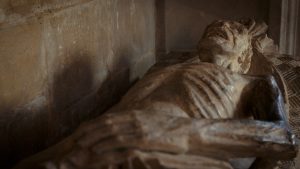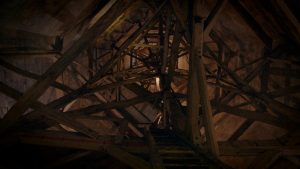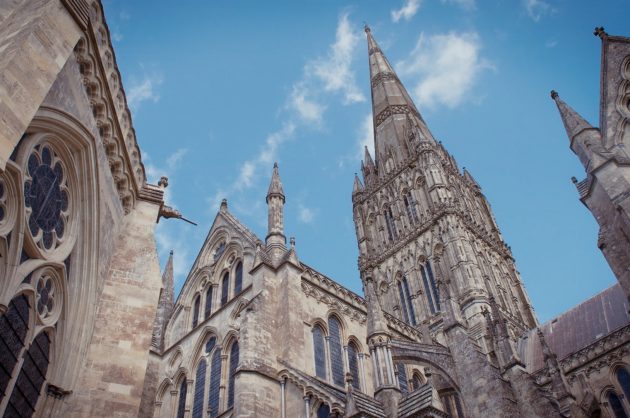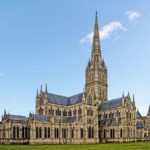Having become enthralled by readings of William Golding’s The Spire, I decided to embark on my own kind of pilgrimage to Salisbury – where Golding was a school teacher – and in particular to Salisbury Cathedral. In John Carey’s authoritative biography of Golding, he writes that ‘the daily experience of watching the rebuilding of Salisbury Cathedral’s spire from his classroom window must have been part of the book’s gestation’ (250). Golding never identifies or places the cathedral in the novel and in fact, the provisional title of the novel was Barchester Spire (Carey, 250); an allusion, perhaps, to Anthony Trollope’s Barchester Towers based on the fictional cathedral city of Barchester. During a conversation with the literary critic Frank Kermode, standing at the bottom of the spire at Salisbury cathedral, Kermode asked Golding how he had researched cathedral construction. Golding answered, ‘I just came here and said to myself, “If I were to build a spire, how would I go about it”’ (Carey, 285). Essentially, it doesn’t really matter whether the spire in Golding’s novel can be definitively identified as Salisbury Cathedral’s spire; what matters most is that the construction of this great spire inspired Golding to create his brilliant and haunting fiction.
As you approach the city of Salisbury, the eye is necessarily drawn to the cathedral and the spire which dominates the skyline. Even from some distance, it is a most impressive sight; the spire really does seem to be ‘springing, projecting, bursting [and] erupting from the heart of the building’ (8) as Dean Jocelin imagines in The Spire. The spire is the highest in the United Kingdom and the fact that it was constructed around 1330 but still imperiously presides over Salisbury is, quite frankly, astonishing.
Outside of the cathedral itself, The New Inn on New Street is the home of the builders and Dean Jocelin visits here himself towards the end of the novel. He visits Roger Mason who has ‘turned to drink’ after his experience working on the spire. Jocelin is ejected from the inn and ends up in an alley at the crossing of the High Street and then returned to the cathedral.
Surrounding the cathedral is the Cathedral Close; a beautiful set of buildings including private houses, a school and a museum. What strikes the visitor the most is the tranquillity of this area – as one walks towards the cathedral, the noise of the city seems to dissipate. The lawn grounds are lovely (ideal for picnics!) and the cathedral an excellent example of early English Gothic architecture. Like so many cathedrals, its basic layout is in the shape of a cross. Despite there being a lot of visitors on the day I visited, the inner cathedral possessed a wonderful and ethereal quality.
However, as our guide pointed out, the cathedral would have been quite different in the fourteenth century. Medieval cathedrals were busy places; often designated as meeting places for pilgrims and locals, in addition to the ecclesiastical services performed daily. With the added disruption of the building work on the spire, it is clear that the level of noise in the cathedral would have been very distracting and at times, almost unbearable. This is evoked in The Spire, in which religious services are suspended during the work.

Inside the cathedral, some of the key places from the novel can be found. For instance, Dean Jocelin describes how he would like his tomb to look: ‘himself without ornament, lying stripped in death of clothing and flesh, a prone skeleton lapped in skin, head fallen back, mouth open’. Thomas Bennet’s tomb in the cathedral is remarkably similar to Golding’s description. One can gaze at the pillars supporting the mighty spire and see how they bend under the strain, reflecting the metaphorical and literal strain of the spire from the novel.
Unlike its counterpart in the novel, Salisbury Cathedral does have foundations, although these were not ideal for the construction of the spire. It was saved from falling by a number of later additions of support and buttressing, which can be seen on one of the Cathedral’s Tower Tours.

This is quite an experience and certainly not for the faint-hearted or for anyone who suffers from a fear of heights! There are 332 steps – many are winding and made of stone, others are wooden and restrictive. The reward though, is well worth it. Gazing up at the inner body of the spire, which seems to go on forever, is wonderful, and offers the chance to appreciate the work of all the people who helped to support the spire through a complicated series of buttresses.
It’s also possible to go outside and view the panoramic views of Salisbury afforded by the height of the spire. It is this moment on my visit that I really began to understand Dean Jocelin’s obsession with the construction of the spire – the beauty of the landscape, the serenity, and even, perhaps, the feeling of mastery over all that could be surveyed.


